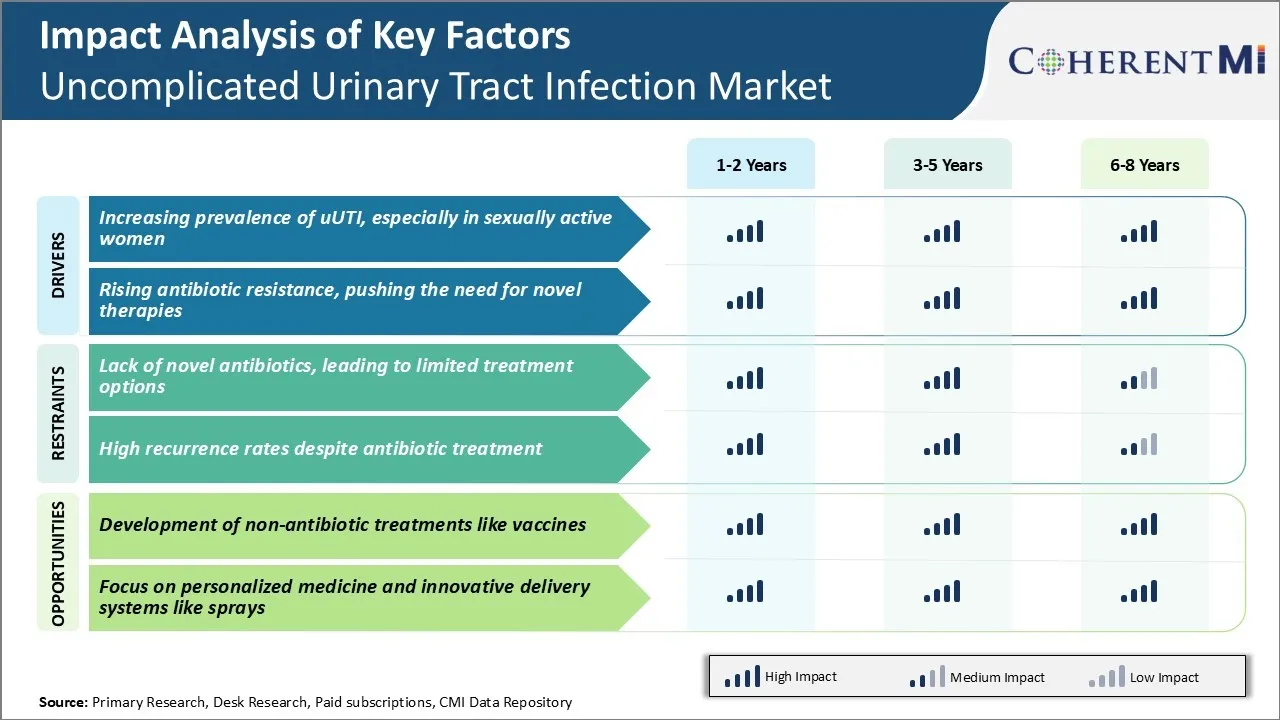Marché des infections urinaires non compliquées ANALYSE DE LA TAILLE ET DU PARTAGE - TENDANCES DE CROISSANCE ET PRÉVISIONS (2024 - 2031)
Le marché des infections urinaires non compliquées est segmenté par traitement (antibiotiques, vaccins), par type de pathogène (Escherichia Coli, Kleb....
Marché des infections urinaires non compliquées Tendances
Pilote du marché - Augmentation de la prévalence de l'UTI, particulièrement chez les femmes sexuellement actives
La prévalence des infections urinaires non compliquées (UUTI) a augmenté de façon significative au cours de la dernière décennie. Les données issues de diverses études épidémiologiques et des dossiers hospitaliers indiquent clairement que les uUTI sont l'une des infections bactériennes les plus fréquentes chez les femmes, en particulier chez les femmes sexuellement actives en âge de procréer. Les uUTI surviennent lorsque certaines bactéries qui vivent habituellement dans l'intestin, comme E. coli, entrent et se multiplient dans l'urètre ou la vessie.
Les études portant sur les étudiantes ont révélé que les taux d'UTI étaient alarmants, plus de la moitié d'entre elles signalant un ou plusieurs épisodes de cystite ou d'urétrite au cours de la seule année écoulée. La nature récurrente de ces infections en fait également une cause majeure de morbidité, de journées de travail manquées/collège et de qualité de vie réduite.
On s'attend à ce que les cas d'UTI acquis sexuellement continuent d'augmenter régulièrement dans les années à venir. Dans l'ensemble, la transition épidémiologique vers l'augmentation de l'incidence de l'UTI, en particulier dans les pays en développement, pose un grave problème de santé publique et constitue un facteur important qui accroît la croissance de ce marché.
Conducteur du marché - Résistance accrue aux antibiotiques, poussant le besoin de thérapies nouvelles
L'une des plus grandes préoccupations associées aux UUTI ces derniers temps a été la résistance antimicrobienne croissante des espèces bactériennes infectantes communes. Des décennies d'abus massif et d'utilisation excessive d'antibiotiques de première ligne comme le triméthoprime-sulfaméthoxazole et les fluoroquinolones ont conduit à une diminution substantielle de leur efficacité pour traiter même les cas simples d'UTI.
L'émergence de souches multirésistantes d'uropathogènes comme Escherichia coli est de plus en plus signalée par les hôpitaux et les communautés du monde entier. Il s'agit d'une tendance inquiétante puisque les patients atteints d'UTI récurrents ou résistants ont des options de traitement limitées et présentent un risque élevé de complications.
Les antibiotiques existants sont également associés à des effets secondaires comme des troubles gastro-intestinaux et rarement même des réactions d'hypersensibilité graves. Le besoin de doses multiples par jour et de longs cours de traitement a des répercussions supplémentaires sur la conformité. Avec l'approfondissement de la crise de la résistance aux antibiotiques, il est urgent de trouver de nouveaux médicaments et des solutions de rechange non antibiotiques pour les UTI non compliquées qui sont sûrs, efficaces et qui peuvent surmonter la résistance émergente.
Les entreprises poursuivent activement des méthodes novatrices de livraison de médicaments, de nouveaux mécanismes d'action et ciblent les interactions hôte-pathogène pour développer des thérapies supérieures dont elles ont tant besoin. On s'attend à ce que le succès de ces efforts entraîne une croissance importante du marché des infections urinaires non compliquées.

Défi du marché - Manque d'antibiotiques nouveaux, menant à des options de traitement limitées
Le marché des infections des voies urinaires est confronté à un défi majeur en raison de l'absence de nouveaux antibiotiques qui entrent sur le marché. La plupart des antibiotiques actuellement disponibles pour le traitement des ITU sont sur le marché depuis de nombreuses décennies. En raison de la surutilisation et de l'utilisation abusive de ces antibiotiques existants, de nombreuses souches bactériennes ont développé une résistance contre eux. Cette résistance croissante aux antibiotiques a rendu ces antibiotiques communs inefficaces dans le traitement de plusieurs cas d'ITU.
Le nombre de souches bactériennes multirésistantes infectant les patients est en augmentation. Cela laisse aux médecins des options de traitement très limitées pour ces infections résistantes aux antibiotiques. Le pipeline de recherche sur les antibiotiques reste également relativement sec, et peu de nouvelles classes d'antibiotiques sont en cours de développement.
Les grandes sociétés pharmaceutiques ont également ralenti ou arrêté les investissements dans la recherche et le développement d'antimicrobiens en raison d'un attrait commercial moindre que dans d'autres domaines. Cette pénurie d'antibiotiques nouveaux peut limiter considérablement les options de traitement que les médecins peuvent choisir dans les années à venir s'ils ne sont pas traités, ce qui menace notre capacité à traiter les infections courantes.
Possibilités de marché - Développement de produits non antibiotiques Des traitements comme les vaccins
Le marché des infections des voies urinaires non compliquées offre une occasion importante de développer des traitements non antibiotiques comme les vaccins. Actuellement, les antibiotiques constituent le pilier du traitement, mais en raison de leur résistance croissante, leur efficacité diminue avec le temps. Cela laisse une lacune importante dans l'armement qui peut être comblé par des vaccins.
Les vaccins ciblant les souches bactériennes les plus courantes responsables de la majorité des ITU peuvent aider à prévenir l'apparition d'infections en premier lieu dans les populations vulnérables comme les femmes âgées. Plusieurs candidats au vaccin sont en phase de développement ciblant des agents pathogènes comme Escherichia coli.
S'ils sont développés avec succès, ces vaccins peuvent se révéler être un changement de jeu pour la gestion de l'ITU. Ils peuvent protéger les populations vulnérables contre les infections et réduire l'utilisation d'antibiotiques, ce qui freine le développement de la résistance. Les vaccins en tant que thérapies préventives peuvent transformer le paradigme de traitement actuel et le marché des UTI non compliquées.
Il s'agit d'une occasion commerciale massive pour les entreprises qui investissent dans ce domaine de mettre sur le marché de nouvelles options de prévention non antibiotiques.